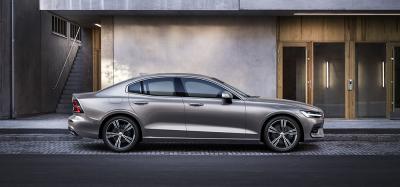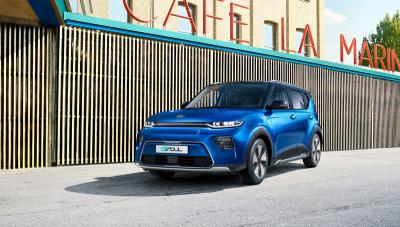Twingo reloaded. A city car with an attitude, jaunty and cheeky, mechanically out of the ordinary starting with its rear mounted engine and rear-wheel drive, freeing the front end of the car from most of its mechanical parts.
In a rather standardized sector, the efforts made by Renault engineers (actually, together with Daimler) in exploring new solutions represents a real breath of fresh air, and without any apparent sacrifice, at least for a car destined to urban driving, or even weekend getaways.
Heir of a glorious line of cars, all descending - at least in spirit - from the unforgotten R4, still in the heart of many who owned it back in the 70s. Fully re-invented with its five-door configuration (first time in Twingo’s history), fuel saving rear mounted engines, although petrol is currently the only fuel option available, generous interior space for four passengers and extreme maneuverability in city traffic.
LONG WHEELBASE, SHORT BODY
Shorter in appearance, but the reduced overhangs - 63 cm at the front and 47 cm at the rear - and extended wheelbase, 2.49 meters (13 cm more than the old Twingo) maximize passenger volume, comfortable for four passengers, improve visibility as well as improving the perception of the overall dimensions of the vehicle: 3.59 meters in length (10 cm less than the previous series), a width of 1.65 m and a height of 1.55 m , enough to accommodate even a couple of chubby friends behind. Designed to provide enough passenger space, the new Twingo boasts more than adequate loading space - as long as one does not overdo it with briefcases and parcels – with its shallow and long 219-liter boot, although occasional bulky items could also be loaded after partially or completely folding the rear seats, obtaining a perfectly flat floor, and if the front passenger seat is folded as well, the result is a perfectly flat 2.31-meter loading space from the boot to dashboard.
Minimal-chic dashboard design but quite complete, able to transform your smartphone or tablet into a true extension of the car through the integrated Renault R & Go system which connects your device through a dedicated App allowing the driver to access, through a tablet or a smartphone’s display all the vehicle’s functions, grouped into four different settings: navigation, multimedia, telephone and vehicle. Constantly updated CoPilot maps and traffic alerts can be accessed also offline as well as information on speed cameras, radio functions, phone calls and messages (SMS-to-speech function), besides the traditional instruments we all expect to find in a car, tachometer and eco-driving systems to save fuel. The brightness of the interior, is the result of a few customized solutions: aluminum pedals on the “sportier” Energy Sport version and an electrically operated OpenAir panoramic roof able to provide a 71 cm opening in the roof, are just a couple of examples.
The Twingo’s forward driving position, immediately behind the short rounded bonnet, coupled to the absence of the engine and an opening of a few centimeters just enough to reach the battery or top up the brakes, radiator and windshield wipers fluids, all contribute in enhancing the driver’s front visibility.
“COMING FROM BEHIND”
Designed in collaboration with Daimler and built on the same technical platform used for the Smart Fortwo and Forfour, the New Twingo boasts a few very interesting solutions, such as the rear positioning of the engine, an unusual choice, but one which allows the vehicle to turn the front wheels at 45 ° (against the 30 ° usually possible on traditional city cars) to facilitate driving on cramped roads and maneuvering in tight spaces with just 8.6 meters needed for a complete u-turn.
Furthermore, the different weight distribution 45% on the front and 55% on the rear (instead of the 70-30 offered by traditional front-wheel drive cars) represents another advantage. No, we are not talking about the low center of gravity of a race car, as we are in fact talking about a modest, rear wheel drive city car, but a solutions that translates in precise steering and dynamic performance, enhanced by the light and nimble chassis and a VGR (Variable Gear Ratio) electric power steering which makes every maneuver simple and effortless.
Under the luggage compartment – because it is precisely here that the engine lies transversely and inclined at 49 ° - we find a Renault three-cylinder petrol engine, available in two versions: the more powerful CeT 0.9 liter turbocharged engine capable of delivering 90 hp, and the 70hp 1liter (999 cc to be exact) SCe, equipped with a five-speed manual transmission or, only for the CeT version, an automatic EDC (Efficient Dual Clutch) six-speed dual clutch. At the moment a Diesel option does not seem to be in the pipeline since the new Twingo can count on more than adequate speed performance, respectively 165 and 151 km / h, moderate fuel consumption, between 23.8 and 22.2 km / liter, and certified Euro6 levels of harmful emissions.
The special chassis includes mixed suspension with independent front wheel suspensions, which greatly benefit from the engine being moved to the rear, and a 22 mm anti-roll bar, just enough to enhance driving comfort while maintaining an adequate contact patch with the road surface, while at the rear a De Dion type rigid axle is located just below the engine drive shaft, allowing enough space for the boot. The dynamic management of the car is entrusted, as expected, to electronic assistance devices, such as the ESP for enhanced stability, Hill Start Assist, Abs with Afe assistance for emergency braking, the Visio System lane changing alarm, a rear view camera displayed on the tablet’s or smartphone’s display, cruise control (on request) and of course Tpms for tire pressure monitoring.
Moreover, the choice of wheels represents another interesting aspect, with alloy or steel wheels (widely customizable with three wheel covers for the 15-inch steel rim or four for the 15 and 16 " alloy rims), with different tire sizes between the front and rear axle, considering the lighter weight on the front axle: 165/65 R15 on the front and 185/60 R15 on the rear, or alternatively, 185/50 R16 and 205/45 R16.

Short hood, short tail, long wheelbase and short overhangs are the ingredients to give the new Twingo maximum agility in city traffic maintaining an appreciable comfort for four passengers

The long wheelbase guarantees enough room for four passengers and 219 to 908 liters of luggage and parcels along its 231 cm long loading space

The mechanical layout is matched by 15- or 16-inch wheels, with different tires sizes on both axles able to guarantee greater traction and maneuverability

Not only a change of looks for the third generation of the Twingo, but cutting-edge solutions quite unusual on a city car, such as a rear engine and rear-wheel drive for improved maneuverability









